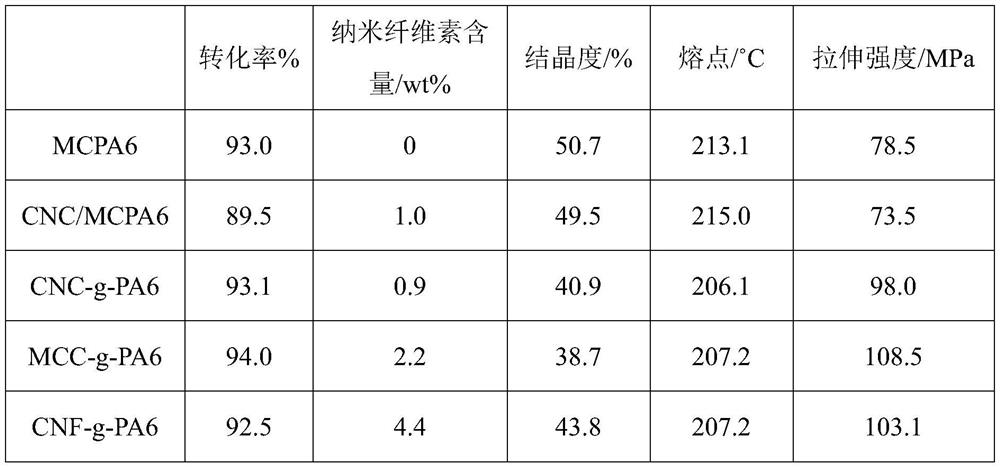In-situ preparation method of nano cellulose surface grafted nylon 6 composite material
A nano-cellulose, in-situ preparation technology is applied in the field of in-situ preparation of nano-cellulose surface grafted nylon 6 composite materials, which can solve the problems of insufficient interface bonding and uneven dispersion of nano-materials, so as to reduce polymerization inhibition, The effect of improving overall performance and avoiding insufficient heat resistance
- Summary
- Abstract
- Description
- Claims
- Application Information
AI Technical Summary
Problems solved by technology
Method used
Image
Examples
Embodiment 1
[0041] Weigh 10.00g of cellulose nanocrystals (CNC) and vacuumize at 120°C to remove water for 48h, and after cooling in N 2 Add 100mL of toluene under the atmosphere, sonicate for 30min, then add 30.0mL of triethylamine and 27.0mL of 2,4-toluene diisocyanate successively, stir and heat at 35°C for 24h, centrifuge after the reaction to obtain a precipitate. Wash with toluene to remove unreacted triethylamine and 2,4-toluene diisocyanate, centrifuge to discard the supernatant, and dry the precipitate in a vacuum oven at 30°C for 12 hours; then, the dried isocyanated Cellulose nanocrystal powder is placed in the flask and evacuated for 10min, under N 2 Add 500mL of toluene under the atmosphere, ultrasonic for 0.5h; weigh 95.60g of caprolactam, vacuumize and remove water at 110°C for 0.5h, cool it under N 2 Add 500mL of toluene at low temperature and stir until completely dissolved; slowly add the toluene solution of caprolactam into the toluene mixture of isocyanated cellulose ...
Embodiment 2
[0044] Weigh 10.00g of microcrystalline cellulose nanocrystals (MCC) and vacuumize at 120°C to remove water for 48h, and after cooling in N 2 Add 100mL of toluene under the atmosphere, sonicate for 30min, then add 60.0mL of triethylamine and 54.0mL of 2,4-toluene diisocyanate in sequence, stir and heat at 45°C for 24h, centrifuge after reaction to obtain a precipitate. Wash with toluene to remove unreacted triethylamine and 2,4-toluene diisocyanate, centrifuge to discard the supernatant and dry in a vacuum oven at 30°C for 12 hours; then, the dried isocyanated fibers Prime nanocrystalline powder is placed in the flask and evacuated for 10min, under N 2 Add 900mL of toluene under the atmosphere, ultrasonic for 0.5h; weigh 85.60g of caprolactam, vacuumize and remove water at 110°C for 0.5h, cool it under N 2 Add 900mL toluene at low temperature and stir until completely dissolved; slowly add the toluene solution of caprolactam into the toluene mixture of isocyanated cellulose n...
Embodiment 3
[0047] Weigh 10.00g of cellulose nanofibers (CNF) and vacuumize at 120°C to remove water for 48h, and after cooling in N 2 Add 500mL of toluene under the atmosphere, sonicate for 30min, then add 30.0mL of triethylamine and 27.0mL of 2,4-toluene diisocyanate in sequence, stir and heat at 45°C for 24h, centrifuge after reaction to obtain a precipitate. Wash with toluene to remove unreacted triethylamine and 2,4-toluene diisocyanate, centrifuge to discard the supernatant and dry in a vacuum oven at 30°C for 12 hours; then, the dried isocyanated fibers Prime nanocrystalline powder is placed in the flask and evacuated for 10min, under N 2 Add 50mL of toluene under the atmosphere, sonicate for 0.5h; weigh 42.80g caprolactam, vacuumize and remove water at 110°C for 0.5h, cool it under N 2 Add 200mL of toluene at low temperature and stir until completely dissolved; slowly add the toluene solution of caprolactam into the toluene mixture of isocyanated cellulose nanocrystals, raise the...
PUM
| Property | Measurement | Unit |
|---|---|---|
| degree of grafting | aaaaa | aaaaa |
| degree of grafting | aaaaa | aaaaa |
| degree of grafting | aaaaa | aaaaa |
Abstract
Description
Claims
Application Information
 Login to View More
Login to View More - R&D
- Intellectual Property
- Life Sciences
- Materials
- Tech Scout
- Unparalleled Data Quality
- Higher Quality Content
- 60% Fewer Hallucinations
Browse by: Latest US Patents, China's latest patents, Technical Efficacy Thesaurus, Application Domain, Technology Topic, Popular Technical Reports.
© 2025 PatSnap. All rights reserved.Legal|Privacy policy|Modern Slavery Act Transparency Statement|Sitemap|About US| Contact US: help@patsnap.com

